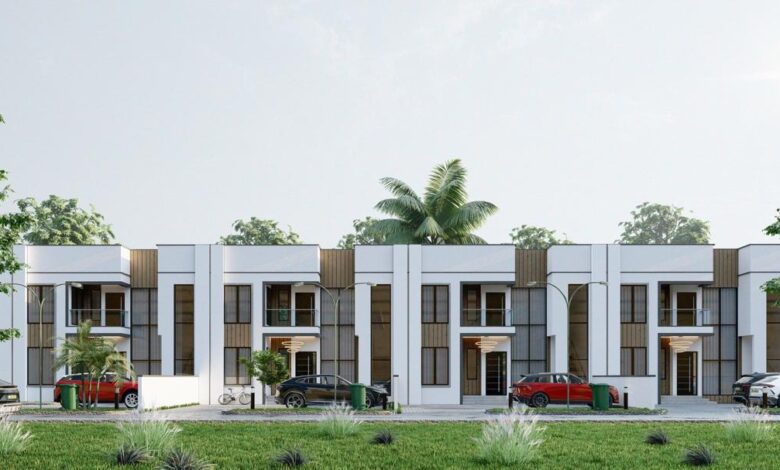Funmi Branco: As Ogun rebuilds government quarters decades after for efficiency, functionality

The news calmed frayed nerves in many quarters: finally, after years of complaints, the Ogun State House of Assembly Complex, the Legislative Quarters, and the Commissioners’ Quarters are receiving a massive facelift. Extensive structural assessments by the Ministry of Housing had revealed that the existing buildings—constructed in 1976—as severely dilapidated and unsafe. The houses built by the military government after the creation of the state do not meet modern engineering requirements. Most of the houses have no German floor and, during rains, the rooms are full of water. That is not all: the wiring system is faulty. And that is why, sometimes, people bathing in those buildings lament that they experience electric shocks. The structural deficiencies in the buildings are all too obvious. All the buildings are leaking, even though the roofing has been changed two or three times, costing the government a fortune.
The state government said as much while pointing out that this initiative is part of the efforts being made to modernize critical government infrastructure and ensure safe, functional housing for top public officials. As it noted, despite multiple renovation attempts over the years, the structures had continued to deteriorate, resulting in high maintenance costs with minimal improvement. Commissioner for Housing, Hon. Jagunmolu Omoniyi, said the reconstruction project was necessary to align the state’s public infrastructure with modern safety, design, and efficiency standards, adding that that the decision was guided by the National Building Code of Nigeria (NBC, 2006), which stipulates that public buildings must meet minimum standards of safety and habitability. His words: “The existing Legislative and Commissioners’ Quarters were constructed in 1976, nearly 50 years ago. Over the years, successive governments have spent enormous sums on repairs and maintenance, but these have yielded diminishing results. A technical evaluation conducted by the Ministry confirmed that the structures are no longer safe for habitation. In line with global best practices and the provisions of the National Building Code, the State Government has chosen to rebuild these facilities for long-term sustainability.”
The new developments, the commissioner promised, would be modern, energy-efficient, and environmentally friendly, with upgraded utilities, improved spatial design, and smart infrastructure to enhance functionality, and reflect the State’s broader commitment to urban renewal and environmental responsibility. Fantastic.
If structures are no longer safe for habitation, with high maintenance costs and minimal improvement despite multiple renovations; if modern, energy-efficient, and environmentally friendly designs with upgraded utilities, improved spatial design, and smart infrastructure are a viable option, and if the National Building Code are being violated, then acting to enhance public safety, administrative efficiency and support urban renewal and environmental responsibility is the progressive step for a visionary administration to take. In any case, with first class airports and sea ports and with industries and industrial estates springing up on a regular basis as the Abiodun government attracts business from far and wide, it is only fair that government quarters fit into the emerging landscape. Besides, with priority given to local contractors, artisans, and suppliers to boost job creation and stimulate the local economy, this project can only enhance the fortunes of Ogun State. Why continue to expend scarce resources on isolated repairs when you can undertake a holistic rehabilitation and save significant costs?
Actually, the reconstruction tallies with the urban renewal drive of the government. As Governor Abiodun said earlier in the year while inspecting ongoing road construction projects in Ogun East Senatorial District: “We have built over 4,000, going to 5,000 affordable houses for medium and upper-income earners across the state. In Ilaro, they are eager for me to come and commission those houses. We have them in Iperu, Sagamu, and two in Abeokuta. We started our urban regeneration at the GRA in Abeokuta and began building the PMB estate also in Abeokuta. You can feel my excitement today because I can look at all that and even see the clips from the airport where the conveyor belts, metal detectors, and luggage scanners have started working, and I said to myself, ‘Something new has happened in Ogun State,’ and this needs to be sustained.”
That’s not being facetious or political; it’s stating hard facts. If you wish to experience Prince Abiodun’s housing projects in Ogun State, take a trip to the Prince Court Estate, Idi-Aba, Abeokuta: the 750 housing units across Phases 1, 2, and 3 there are a marvel, as are the 527 units in Prince Court Estate, Kobape, which is along the Siun-Sagamu Expressway. And there’s another Prince Court Estate, Sagamu, with 200 units of state-of-the-art housing. The story is the same in Prince Court Estate, Itanrin, Ijebu Ode (200 units); and Prince Court Estate, Ilaro (100 units). The Gateway Aviation Village, Iperu, has 200 units; Kings Court Estate, Oke Mosan, Phase 1 & 2, has 200 units, as does the Kings Court, Warewa. At the Ibara GRA Regeneration Scheme, you have 250 units, and double this figure when you go to the Igbeba Ijebu Ode GRA Regeneration. If you are familiar with the President Muhammadu Buhari (PMB) Estate, you know that it has 250 semi-detached and fully-detached duplex units. That is apart from the Civil Servants Village, a project on a 50-hectare land for state workforce to buy land and build houses. Apparently, the different designs are meant to cater to the different segments of the Ogun population. Indeed, Governor Abiodun has an ambitious plan to deliver 10,000 affordable houses before the end of his tenure. He is a talk-and-do Governor.
Given the phenomenal standards of the housing schemes, it is incumbent on the Ogun State Government to ensure that the scheduled renovations at the Ogun State House of Assembly Complex, the Legislative Quarters and the Commissioners’ Quarters meet the required standards. And the Ogun State Government is fully conscious of this: it believes that the buildings should last more than 50 years, so Ogun State can retain its pride of place among Nigeria’s states. This initiative is certainly not an act of extravagance but a necessary investment in public safety and administrative efficiency. As has been observed already, the move is driven by foresight and prudence: delaying reconstruction could expose officials living in the quarters to greater risks, and cause successive governments to face even greater financial and safety challenges. It is a component of the Ogun State Urban and Housing Renewal Master Plan, which aims to replace obsolete infrastructure with durable, cost-effective, and sustainable developments that meet modern needs. That, certainly, is the way to go.
Branco sent this piece through [email protected]





